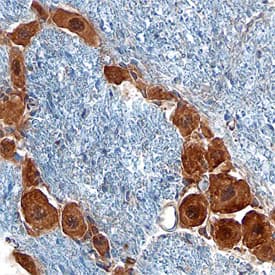Mouse GDF-15 Antibody
R&D Systems, part of Bio-Techne | Catalog # AF6385

Key Product Details
Species Reactivity
Validated:
Cited:
Applications
Validated:
Cited:
Label
Antibody Source
Product Specifications
Immunogen
Ser189-Ala303
Accession # Q9Z0J7
Specificity
Clonality
Host
Isotype
Scientific Data Images for Mouse GDF-15 Antibody
GDF‑15 in Mouse Brain.
GDF-15 was detected in perfusion fixed frozen sections of mouse brain (trigeminal ganglion) using Sheep Anti-Mouse GDF-15 Antigen Affinity-purified Polyclonal Antibody (Catalog # AF6385) at 15 µg/mL overnight at 4 °C. Tissue was stained using the Anti-Sheep HRP-DAB Cell & Tissue Staining Kit (brown; Catalog # CTS019) and counterstained with hematoxylin (blue). Specific staining was localized to neuronal cytoplasm. View our protocol for Chromogenic IHC Staining of Frozen Tissue Sections.Applications for Mouse GDF-15 Antibody
Immunohistochemistry
Sample: Perfusion fixed frozen sections of mouse brain (trigeminal ganglion)
Reviewed Applications
Read 1 review rated 5 using AF6385 in the following applications:
Formulation, Preparation, and Storage
Purification
Reconstitution
Formulation
Shipping
Stability & Storage
- 12 months from date of receipt, -20 to -70 °C as supplied.
- 1 month, 2 to 8 °C under sterile conditions after reconstitution.
- 6 months, -20 to -70 °C under sterile conditions after reconstitution.
Background: GDF-15
GDF-15 (Growth/differentiation factor 15; also PTGF, PDF, PL-74 and NAG-1) is a 25-30 kDa homodimeric member of the TGF-beta superfamily of proteins. In rodent, GDF-15 is expressed in a diverse population of activated cell types, including hepatocytes, macrophages, Schwann cells, cardiomyocytes, osteoblasts, adipocytes, and epithelium of the small intestine and mammary gland. Functionally, GDF-15 has multiple effects, some tissue specific, including the induction of ACRP30 secretion from fat, an attenuation of the adverse effects of cardiac hypertrophy, and serving as a trophic factor for motor and sensory neurons. Mouse GDF-15 is synthesized as a 273 amino acid (aa) proprecursor that contains a cleavable 26 kDa, 158 aa glycosylated prodomain (aa 31-188) and a 12-14 kDa, 115 aa mature region (aa 189-303). In human, certain cells are noted to secrete an uncleaved 40 kDa proprecursor that, as a disulfide-linked homodimer, would run at about 80 kDa in nonreducing SDS-PAGE. Over aa 189-303, mouse GDF-15 shares 97% and 67% aa identity with rat and human GDF-15, respectively.
Long Name
Alternate Names
Gene Symbol
UniProt
Additional GDF-15 Products
Product Documents for Mouse GDF-15 Antibody
Product Specific Notices for Mouse GDF-15 Antibody
For research use only
